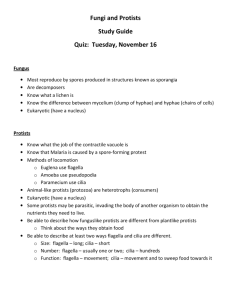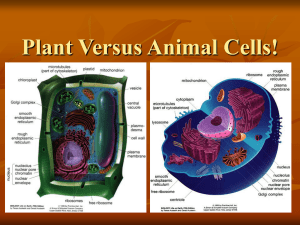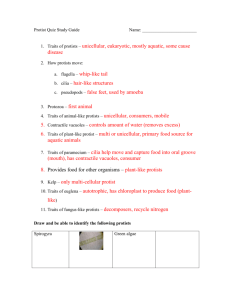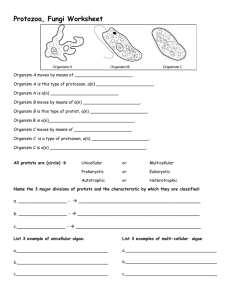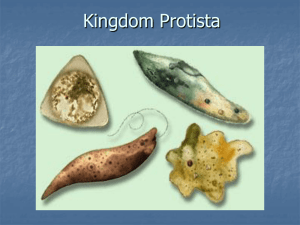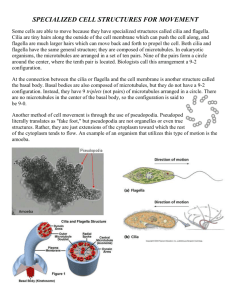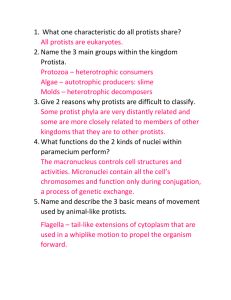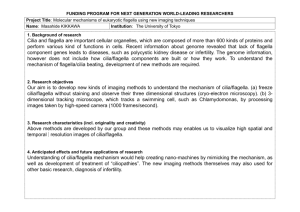Unit 2.qxd - Biology Junction
advertisement
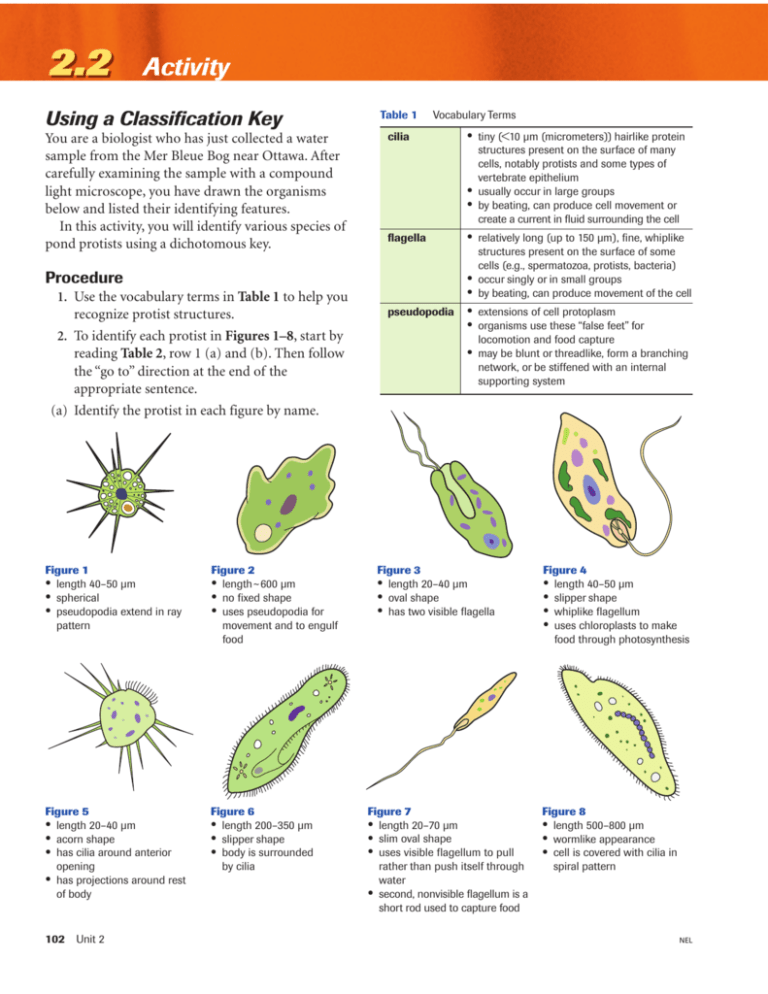
2.2 Activity Table 1 Using a Classification Key Vocabulary Terms cilia You are a biologist who has just collected a water sample from the Mer Bleue Bog near Ottawa. After carefully examining the sample with a compound light microscope, you have drawn the organisms below and listed their identifying features. In this activity, you will identify various species of pond protists using a dichotomous key. • • • flagella Procedure 1. Use the vocabulary terms in Table 1 to help you recognize protist structures. pseudopodia 2. To identify each protist in Figures 1–8, start by reading Table 2, row 1 (a) and (b). Then follow the “go to” direction at the end of the appropriate sentence. • • • • • • tiny (<10 µm (micrometers)) hairlike protein structures present on the surface of many cells, notably protists and some types of vertebrate epithelium usually occur in large groups by beating, can produce cell movement or create a current in fluid surrounding the cell relatively long (up to 150 µm), fine, whiplike structures present on the surface of some cells (e.g., spermatozoa, protists, bacteria) occur singly or in small groups by beating, can produce movement of the cell extensions of cell protoplasm organisms use these “false feet” for locomotion and food capture may be blunt or threadlike, form a branching network, or be stiffened with an internal supporting system (a) Identify the protist in each figure by name. Figure 1 • length 40–50 µm • spherical • pseudopodia extend in ray pattern Figure 2 • length~600 µm • no fixed shape • uses pseudopodia for movement and to engulf food Figure 5 length 20–40 µm acorn shape has cilia around anterior opening • has projections around rest of body Figure 6 • length 200–350 µm • slipper shape • body is surrounded by cilia • • • 102 Unit 2 Figure 3 • length 20–40 µm • oval shape • has two visible flagella Figure 7 length 20–70 µm slim oval shape uses visible flagellum to pull rather than push itself through water • second, nonvisible flagellum is a short rod used to capture food • • • Figure 4 • length 40–50 µm • slipper shape • whiplike flagellum • uses chloroplasts to make food through photosynthesis Figure 8 length 500–800 µm wormlike appearance cell is covered with cilia in spiral pattern • • • NEL Activity 2.2 Table 2 Dichotomous Key for Protist Identification 1 (a) Cilia are present. (b) Cilia are absent. Go to 6 Go to 2 2 (a) Flagella are present. (b) Flagella are absent. Go to 4 Go to 3 3 (a) Organism is asymmetrical and has pseudopodia. (b) Organism is spherical and has needlelike pseudopodia. Amoeba 4 (a) Organism has a single flagellum. (b) Organism has two or more flagella. Go to 5 Chilomonas 5 (a) Organism has chloroplasts. (b) Organism lacks chloroplasts. Euglena Peranema 6 (a) Cilia are present around entire body; no projections around body. (b) Cilia are present only around anterior opening; projections around body. Go to 7 (a) Organism is 200–350 µm long. (b) Organism is 500–800 µm long. Paramecium Spirostomum 7 Actinophrys Halteria Analysis (b) What are three characteristics used to classify protists? (c) Study the features of other pond protists (Figure 9) and make a list of additional characteristics that could be used to classify these organisms. Synthesis (d) Working in a group, give each organism in Figure 10 an imaginary genus and species name. Record these names on one piece of paper. On a separate piece of paper, make a dichotomous key that allows others in the class to identify each of the protists. Figure 9 Pond protists (e) Exchange your key with another group. How successfully did another group use your key? What changes would you make? (f) List criteria that could be used to evaluate a dichotomous key. CAREER CONNECTION Most pond-water microorganisms are harmless. Other microorganisms (e.g., some E. coli) are harmful to human health if present in sufficient quantity. The Walkerton tragedy in Ontario in 2000 emphasized the need for monitoring microorganisms in drinking water. Investigate the opportunities available in this field. What programs are available in Canadian colleges for water-quality technicians? GO www.science.nelson.com Figure 10 Unidentified pond microorganisms NEL Microbiology 103
